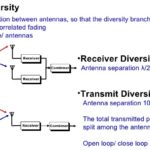In Part 1 we looked at space diversity, which is the simplest form of signal-channel diversity. It has been used with success since the earliest days of wires and wired links, and it sees new uses in 5G MIMO and other advanced RF systems. We next look at the other very common form of signal-channel diversity.
Q: What is frequency diversity?
A: Frequency diversity means using two or more widely spaced frequency channels to send the same message, usually at the same time, Figure 1. The idea is that channel propagation and interference issues will not affect all frequencies to the same extent, so at least one signal will be received with acceptable SNR.

Q: How does it work?
A: Each transmitter is assigned a frequency at which it must transit, and only at that frequency. Each receiver, in turn, must “tune” to the corresponding frequency channel to receive and recover the intended signal. Simultaneous transmission and reception require multiple transmitters, antennas, and receivers, all of which can be costly in size, cost, power, and management.
Q: Is frequency diversity the same as frequency division multiplexing?
A: Yes and no. Many of the underlying principles are the same – primarily, using different frequencies simultaneously. FDM is it done to allow more independent users in given slice of the spectrum at the same time, with each assigned to one of several closely spaced channels. In contrast, frequency diversity is used to provide a redundant path via another part of the spectrum. Thus, the same ideas related to using different parts of the spectrum ate being employed, but FDM is used to allow more users while frequency diversity is used to enhance system chance of success.
Q: When were frequency diversity and FDM developed – although not known by that designation at the time?
A: In the very early days of “wireless” (as radio was called for many years, and is still known in parts of the world), the transmitters were basic “spark gap” system which broadcast by energizing a coil to high voltage until it sparked across a gap. This resultant signal – which, ironically, is now considered a form of RF interference (RFI) occupied a wide and somewhat untamed band of frequencies at the low end of the electromagnetic spectrum (up to tens of kHz).
As more of these transmitters came into use, the resultant interference caused intolerable RF chaos. Gradually, topologies with tuned circuits and the ability to be selective with use of frequencies within a band were established and became a reality. The tuned radio frequency (TRF) receiver architecture (see “Radio receiver architectures, Part 1—TRF and Superhet”) was a major step in this advance.
Q: What are other types of diversity?
A: Time diversity, closely related to time division multiplexing (TDM), was the last of the three main diversity techniques to be developed and implemented. In this approach, a single link is divided into time slots, and the message is repeated at specified intervals. A synch pulse or series of pulses is used to let the receiver know when the next frame of repeated signals is beginning.
There is also polarization diversity, where two signals are transmitted with their RF energy divided into horizontal and vertical planes. In theory, if the signals arrive undistorted (very difficult to achieve in practice), the two signals remain independent and can be recovered as such.
In some more-advanced systems, instead of planar polarization, circular polarization is used, with one signal’s RF vector rotating clockwise and the other signal’s polarization rotating counterclockwise Figure 2. This allows two signals on the same frequency. It is used in fixed line-of-sight situations and even spacecraft applications as there is a direct, unobstructed path between source and receiver, with no intervening surfaces to distort the polarization (note that when a circularly polarized signal reflects from a flat surface, its polarization is reversed).

Q: Who developed these various diversity techniques?
A: Obviously, no isolated person, team, group, or company developed any of these; there have been countless contributors responsible for the large and equally critical small steps. As Isaac Newton wrote in a letter in 1675 to Robert Hooke (Hooke’s Law): “If I have seen further it is by standing on the shoulders of Giants.”
However, any discussion of advances in diversity and multiplexing must cite the efforts of The Bell Telephone System (now disbanded), its research arm The Bell Telephone Laboratories (created in 1925 and now a shadow of its former self, presently owned by Nokia after passing through several owners) and Bell’s manufacturing arm The Western Electric Company. These groups worked to conceive of innovations, prototype them, field test them, and then manufacture them in high volume for mass-market adoption.







Leave a Reply
You must be logged in to post a comment.